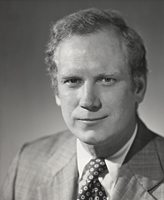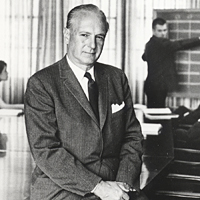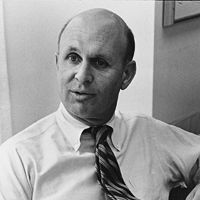Rise
of a management titan
The Kellogg
School is nearly 100 years old, but its modern incarnation as
a management leader traces an entrepreneurial arc dating back
40 years. From humble roots as a resource-strapped commerce
school, Kellogg has leveraged the talents, passion and vision
of some extraordinary people, transforming itself - and the
business world This
is the first of an occasional Kellogg
World series exploring the people and key events in the
Kellogg School's history, in advance of the school's 2008
centennial
By
Matt Golosinski
Lincoln
came from Illinois, as did Walt Disney and Benny Goodman,
for that matter. So it could be done, a person or institution
rising up from the cornfields to national prominence.
Not everything
big, bold and dynamic had to come from somewhere else or have
an Ivy League pedigree. That much was obvious. That much the
University of Chicago had been proving, to the detriment of
Northwestern University's School of Business which, in the
early 1970s, found itself trailing a distant second in the
Second City.
"We couldn't
even see the University of Chicago's dust, let alone eat it,"
says Pete Henderson, recalling the early days of his tenure
as associate dean of administration at Northwestern's business
school from 1971 until 1981.
However,
this situation would gradually and markedly change, exceeding
Henderson's modest expectations that Northwestern could be
merely "more competitive" with Chicago - "be the Avis to their
Hertz," as he says.
Indeed,
even then the school had begun improving, cracking the top
15 on some lists as the decade progressed. In 1981, The
Wall Street Journal took notice in a flattering feature
that highlighted the school's "eclectic curriculum and ties
to [the] 'real world.'"
Most of
Henderson's career at the university occurred before the "Kellogg"
brand emerged, but thanks to strategic moves by two deans,
John Barr and Donald
P. Jacobs, and the school's overall mission realignment,
begun in 1965, the institution would gain fame. Its young,
research-based faculty, innovative culture and collaborative
learning model would all represent a fresh approach not only
at the school, but in business education. Then too, in June
1966 university trustees approved a bold decision to scrap
an established undergraduate business curriculum and focus
instead on graduate-level education. This event announced
an overarching shift in the school's philosophy to emphasize
lifelong learning as a critical tool for leaders grappling
with an increasingly complex and technologically driven global
economy.
Another
momentous change came in September 1969, when the school discarded
the MBA degree and adopted the "Master of Management" degree,
a point of differentiation from peers and a move designed
to illustrate the belief that management had far broader applications
than just business.
 |
|
| Attorney
Dale Park Jr. proved key in securing a $10 million gift
to name the Kellogg School of Management. |
|
| |
|
By 1979,
the school hung on the cusp of greatness.
A fortune
and a face
Early
that year, the air at Northwestern was charged with anticipation
as administrators waited to learn whether the John L. and
Helen Kellogg Foundation, looking to disburse about $40 million
to deserving organizations, would send some of that money
to the business school after considering a proposal put together
chiefly by attorney Dale Park Jr.
"In those
days, $40 million was a huge, huge amount of money," says
Park, adding that the figure was comparable to the Wrigley
estate.
The stakes
were significant. This Kellogg money would provide irrefutable
proof that a prestigious external foundation had noted the
innovations occurring at the school, especially since Jacobs
became dean in 1975 and had launched a series of remarkable
initiatives. Among these were efforts to enhance the school's
international presence, bolster its faculty, and defy the
critics to build an executive education facility - the James
L. Allen Center - that soon attracted universal admiration.
"We announced
our belief that, given the rate of change in the world, education
was not simply a degree-granting conclusion - get your MBA
and then you are finished - but rather the beginning of a
lifelong educational process," says Jacobs, dean for 26 years
until stepping down in 2001 when Dipak
C. Jain assumed the leadership.
Jacobs'
adroit fund raising - he generated about $4 million annually
by 1979 and some $400 million total over his tenure - in conjunction
with his uncanny ability to connect with business leaders,
was key to these successes.
"The fact
of the matter is, I have no ego, so people accept me," explains
Jacobs, the son of a Chicago baker.
For a
rigorous academic who since 1957 had served as a finance professor
at Northwestern, Jacobs demonstrated great skill in bridging
theory and practice, recognizing the importance of bringing
the academy to the real world while listening carefully to
practitioners' insights. The cutting-edge curriculum that
he and his lean administration constantly refined in response
to the market depended on this interplay of ideas.
Capturing
part of the Kellogg Foundation's $40 million could now radically
alter the playing field for the school, providing resources
to redouble its efforts - maybe even affording the chance
to jump past a competitor and move a notch closer to the very
top ranks. But this would require a concerted effort.
Park was
no stranger to important business figures: his father-in-law
was James L. Allen, a co-founder of the venerable consultancy
Booz Allen Hamilton and himself a Northwestern trustee and
longtime member of the school's advisory council who, with
Jacobs, spearheaded a $5.5 million capital campaign for the
Allen Center. But Park did, and still does, identity himself
as a lawyer, not a businessman. In fact, he landed on the
Kellogg Foundation's board only after a colleague at his law
firm introduced him to Helen Kellogg, whom Park went on to
help resolve an important legal matter. After Helen's death
in 1978, Leonard Spacek, the renowned Arthur Andersen managing
partner, became the foundation's president, working with a
relatively small board whose members included W. Keith Kellogg
II; Trans Union CEO and director Jerry Van Gorkom; Baxter
CEO Vernon Loucks Jr.; and Dr. Vincent Dole, the Rockefeller
University physician who discovered methadone as a treatment
for opiate addiction.
"And there
was me," says Park, with a self-deprecating smile.
| |
 |
| |
After
serving as attorney and board chairman for Montgomery
Ward, John Barr became dean of the School of Commerce.
During his 1965-1975 tenure at Northwestern University,
Barr leveraged his business connections to help the school
develop a new focus that would prepare managers for leadership
roles in a more complex world. |
| |
|
"I was
sort of in awe," he admits. "Leonard was something else -
great ethics, so smart. After some of these meetings he would
say to me, 'Dale, are you OK?' Well I was exhausted from trying
to take notes so I could write the minutes! Leonard was so
fast with ideas."
Park says
the board's decision to give away the Kellogg money was unanimous.
The alternative, outlined by Spacek, was to continue the foundation
for years, running up administrative bills. To avoid this
and to place the funds in the best hands, each board member
was to write a letter to Spacek proposing how the foundation
should allocate its resources, recalls Park, who consulted
with Jim Allen about the matter, telling his father-in-law,
"I might be able to get you $1 million for the management
school."
Allen
suggested Park talk with Henderson.
"I had
lunch with Pete and, as we were leaving, he said, 'If you
give us $10 million we'll give you the name of the school,'"
says Park.
Park researched
the origin of the Kellogg fortune back to 1834 and John Preston
Kellogg, father of John Harvey Kellogg and Will K. Kellogg,
the brothers who would, by accident, produce the first pre-cooked
flaked cereal in 1894. This discovery would make the Kellogg
family famous and connect them to the business world - a fact
that Park would accent in an eight-page proposal to Spacek
and the board. In this July 29, 1978, document, Park articulated
the reasons why Northwestern deserved consideration.
Behind
his reasoning lay a belief in education's power.
"If you
want to multiply the effect of a grant, I always thought you
should give it to education," notes Park, "because you don't
just benefit one person; you benefit a tremendous number of
people."
Henderson
could find no flaw in this logic.
A former
Booz Allen Hamilton executive who came to Northwestern seeking
a new career that offered the recent widower flexibility to
raise his three young children, Henderson says he "tried to
play every angle" to ensure the university received some Kellogg
money.
"I called
Leonard Spacek at his home in Palm Springs," Henderson says.
"I told him, 'We would love to come and see you. We think
we've got a wonderful school here, one that would be an appropriate
place for you to designate funds.'"
This zeal
hardly moved the famously circumspect accountant.
"He told
me, 'Let me describe the scene here, Mr. Henderson. There
are 12 nuns in my backyard, five priests in the front yard.
None of them has broken through my defenses. You too are welcome
to come out and stand with those priests and nuns, Mr. Henderson,
but neither will you get into my house."
 |
|
| Former
Associate Dean Pete Henderson helped enhance a variety
of administrative elements during his 1971-1981 tenure,
including student recruitment. |
|
| |
|
It didn't
take a religious conversion for Northwestern insiders to appreciate
how far the business school had come. They knew that daring
changes to its curriculum and scope, begun during the Barr
era of 1965-1975, had then flowered under the entrepreneurial
and visionary Jacobs deanship. But for those outside this
community, the first real appreciation that an important new
player now challenged the top management schools came in early
1979 with news that the Kellogg Foundation was indeed giving
$10 million to Northwestern, creating the J.L. Kellogg School
of Management.
"We had
an office pool in sealed envelopes wagering what we would
receive from them," says Henderson. "The answers ranged from
zero to $10 million. Don's [Jacobs] vote was $10 million;
mine wasn't. I was not that hopeful."
Jacobs
says that a lot of people bet zero, but he felt optimistic
about the school's chances, thanks to Park's efforts to articulate
the administration's plan to bolster its academic reputation
by establishing three major research centers, two endowed
professorships in the area of nonprofit management and management
policy, and four annual research professorships. In addition,
several million was marked to renovate Evanston Apartments,
a seven-story residence complex "in really bad shape," as
it had housed 650 Northwestern undergraduates. Jacobs would
turn the property into a "living-learning center" for graduate
business students.
"Dale
was a very, very important person in the whole thing," says
the Kellogg School's dean emeritus. "He has done more for
Kellogg than almost anybody, and he won't take any credit.
But he deserves a lot of credit."
In a letter,
dated March 12, 1979, Jacobs thanks Park "for having single-handedly
brought about this milestone gift," and pledges his "continuing
efforts to merit the confidence the gift implies."
Jacobs
wryly observes his own reaction to the news of the gift: "I
told Leonard Spacek this was the worst day of my life. Leonard
said, 'What are you talking about? We just gave you $10 million!'
Yes, but for the rest of my life I'm not going to sleep at
night, thinking I should have asked for more. I told them
they should have given us nine-point-nine or nine-point-nine
five - anything but the exact figure we requested," says Jacobs,
laughing. "But Leonard was a straight shooter and he assured
me they wouldn't have given us another dime."
With the
foundation's gift, one of the largest of its kind at the time,
the stage was set for the Kellogg School's meteoric ascent
into the top echelon of management leaders. But to understand
the school's remarkable journey, it is important to note key
changes that occurred during the Barr tenure, and what was
destroyed in order to build.
Next page:
"An innovative and leadership position
in management education"
1 | 2
|



